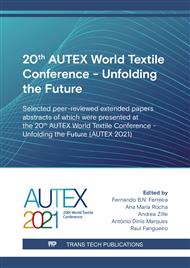[1]
S. Najafi, A. Gholipour-Kanani, N. Eslahi, S.H. Bahrami, Study on release of cardamom extract as an antibacterial agent from electrospun scaffold based on sodium alginate, The Journal of The Textile Institute 112(9) (2021) 1482-1490.
DOI: 10.1080/00405000.2020.1825164
Google Scholar
[2]
S. Baghersad, S.H. Bahrami, M.R. Mohammadi, M.R.M. Mojtahedi, P.B. Milan, Development of biodegradable electrospun gelatin/aloe-vera/poly (ε‑caprolactone) hybrid nanofibrous scaffold for application as skin substitutes, Materials Science and Engineering: C 93 (2018) 367-379.
DOI: 10.1016/j.msec.2018.08.020
Google Scholar
[3]
M. Shokrollahi, S.H. Bahrami, M.H. Nazarpak, A. Solouk, Multilayer nanofibrous patch comprising chamomile loaded carboxyethyl chitosan/poly (vinyl alcohol) and polycaprolactone as a potential wound dressing, International journal of biological macromolecules 147 (2020) 547-559.
DOI: 10.1016/j.ijbiomac.2020.01.067
Google Scholar
[4]
S. Saghebasl, S. Davaran, R. Rahbarghazi, A. Montaseri, R. Salehi, A. Ramazani, Synthesis and in vitro evaluation of thermosensitive hydrogel scaffolds based on (PNIPAAm-PCL-PEG-PCL-PNIPAAm)/Gelatin and (PCL-PEG-PCL)/Gelatin for use in cartilage tissue engineering, Journal of Biomaterials science, Polymer edition 29(10) (2018) 1185-1206.
DOI: 10.1080/09205063.2018.1447627
Google Scholar
[5]
Z.M. Goudarzi, T. Behzad, L. Ghasemi-Mobarakeh, M. Kharaziha, An investigation into influence of acetylated cellulose nanofibers on properties of PCL/Gelatin electrospun nanofibrous scaffold for soft tissue engineering, Polymer 213 (2021) 123313.
DOI: 10.1016/j.polymer.2020.123313
Google Scholar
[6]
P.S. Mohamadi, A. Hivechi, H. Bahrami, N. Hemmatinegad, P.B. Milan, Antibacterial and biological properties of coconut oil loaded poly (ε-caprolactone)/gelatin electrospun membranes, Journal of Industrial Textiles (2021) 1528083721991595.
DOI: 10.1177/1528083721991595
Google Scholar
[7]
M. Rashtchian, A. Hivechi, S.H. Bahrami, P.B. Milan, S. Simorgh, Fabricating alginate/poly (caprolactone) nanofibers with enhanced bio-mechanical properties via cellulose nanocrystal incorporation, Carbohydrate polymers 233 (2020) 115873.
DOI: 10.1016/j.carbpol.2020.115873
Google Scholar
[8]
R. Yao, J. He, G. Meng, B. Jiang, F. Wu, Electrospun PCL/Gelatin composite fibrous scaffolds: mechanical properties and cellular responses, Journal of Biomaterials science, Polymer edition 27(9) (2016) 824-838.
DOI: 10.1080/09205063.2016.1160560
Google Scholar
[9]
O. Yördem, M. Papila, Y.Z. Menceloğlu, Effects of electrospinning parameters on polyacrylonitrile nanofiber diameter: An investigation by response surface methodology, Materials & design 29(1) (2008) 34-44.
DOI: 10.1016/j.matdes.2006.12.013
Google Scholar
[10]
A.G. Akerdi, S.H. Bahrami, Application of heterogeneous nano-semiconductors for photocatalytic advanced oxidation of organic compounds: a review, Journal of Environmental Chemical Engineering 7(5) (2019) 103283.
DOI: 10.1016/j.jece.2019.103283
Google Scholar
[11]
S.C. Coelho, B.N. Estevinho, F. Rocha, Encapsulation in food industry with emerging electrohydrodynamic techniques: Electrospinning and electrospraying–A review, Food Chemistry 339 (2021) 127850.
DOI: 10.1016/j.foodchem.2020.127850
Google Scholar
[12]
H. Souriyan-Reyhani pour, R. Khajavi, M.E. Yazdanshenas, P. Zahedi, M. Mirjalili, Cellulose acetate/poly (vinyl alcohol) hybrid fibrous mat containing tetracycline hydrochloride and phenytoin sodium: Morphology, drug release, antibacterial, and cell culture studies, Journal of Bioactive and Compatible Polymers 33(6) (2018) 597-611.
DOI: 10.1177/0883911518779186
Google Scholar
[13]
M. Shokrollahi, S.H. Bahrami, M.H. Nazarpak, A. Solouk, Biomimetic double-sided polypropylene mesh modified by DOPA and ofloxacin loaded carboxyethyl chitosan/polyvinyl alcohol-polycaprolactone nanofibers for potential hernia repair applications, International Journal of Biological Macromolecules 165 (2020) 902-917.
DOI: 10.1016/j.ijbiomac.2020.09.229
Google Scholar
[14]
S. Ramakrishna, An introduction to electrospinning and nanofibers, World Scientific2005.
Google Scholar
[15]
Q.P. Pham, U. Sharma, A.G. Mikos, Electrospinning of polymeric nanofibers for tissue engineering applications: a review, Tissue engineering 12(5) (2006) 1197-1211.
DOI: 10.1089/ten.2006.12.1197
Google Scholar
[16]
T. Sangnim, S. Limmatvapirat, J. Nunthanid, P. Sriamornsak, W. Sittikijyothin, S. Wannachaiyasit, K. Huanbutta, Design and characterization of clindamycin-loaded nanofiber patches composed of polyvinyl alcohol and tamarind seed gum and fabricated by electrohydrodynamic atomization, Asian Journal of Pharmaceutical Sciences 13(5) (2018) 450-458.
DOI: 10.1016/j.ajps.2018.01.002
Google Scholar
[17]
S. Nadem, H. Ziyadi, M. Hekmati, M. Baghali, Cross-linked poly (vinyl alcohol) nanofibers as drug carrier of clindamycin, Polymer Bulletin 77(11) (2020) 5615-5629.
DOI: 10.1007/s00289-019-03027-z
Google Scholar
[18]
S. Sadeghi, J. Nourmohammadi, A. Ghaee, N. Soleimani, Carboxymethyl cellulose-human hair keratin hydrogel with controlled clindamycin release as antibacterial wound dressing, International journal of biological macromolecules 147 (2020) 1239-1247.
DOI: 10.1016/j.ijbiomac.2019.09.251
Google Scholar
[19]
A. Hivechi, S.H. Bahrami, R.A. Siegel, Drug release and biodegradability of electrospun cellulose nanocrystal reinforced polycaprolactone, Materials Science and Engineering: C 94 (2019) 929-937.
DOI: 10.1016/j.msec.2018.10.037
Google Scholar
[20]
A. Hivechi, S.H. Bahrami, R.A. Siegel, P.B. Milan, M. Amoupour, In vitro and in vivo studies of biaxially electrospun poly (caprolactone)/gelatin nanofibers, reinforced with cellulose nanocrystals, for wound healing applications, Cellulose 27(9) (2020) 5179-5196.
DOI: 10.1007/s10570-020-03106-9
Google Scholar
[21]
P. Kuppan, S. Sethuraman, U.M. Krishnan, PCL and PCL-gelatin nanofibers as esophageal tissue scaffolds: optimization, characterization and cell-matrix interactions, J Biomed Nanotechnol 9(9) (2013) 1540-55.
DOI: 10.1166/jbn.2013.1653
Google Scholar
[22]
M. Heidari, S.H. Bahrami, M. Ranjbar-Mohammadi, P. Milan, Smart electrospun nanofibers containing PCL/gelatin/graphene oxide for application in nerve tissue engineering, Materials Science and Engineering: C 103 (2019) 109768.
DOI: 10.1016/j.msec.2019.109768
Google Scholar
[23]
M. Dedić, E. Bečić, B. Imamović, N. Žiga, Determination of clindamycin hydrochloride content in 1% clindamycin lotion, Bull. Chem. Technol. Bosnia Herzeg 50 (2018) 49-54.
Google Scholar
[24]
N.R. Tanha, M. Nouri, Core-shell Nanofibers of Silk Fibroin/Polycaprolactone-Clindamycin: Study on Nanofibers Structure and Controlled Release Behavior, Polymer Science, Series A 61(1) (2019) 85-95.
DOI: 10.1134/s0965545x19010085
Google Scholar
[25]
F.R. Boroojen, S. Mashayekhan, H.-A. Abbaszadeh, The controlled release of dexamethasone sodium phosphate from bioactive electrospun PCL/gelatin nanofiber scaffold, Iranian journal of pharmaceutical research: IJPR 18(1) (2019) 111.
Google Scholar
[26]
V. Leung, F. Ko, Biomedical applications of nanofibers, Polymers for Advanced Technologies 22(3) (2011) 350-365.
DOI: 10.1002/pat.1813
Google Scholar
[27]
M. Castillo-Ortega, I. López-Peña, D. Rodríguez-Félix, T. Del Castillo-Castro, J. Encinas-Encinas, H. Santacruz-Ortega, J. Cauich-Rodríguez, J. Quiroz-Castillo, L. Chan-Chan, I. Lagarda-Diaz, Clindamycin-loaded nanofibers of polylactic acid, elastin and gelatin for use in tissue engineering, Polymer Bulletin (2021) 1-19.
DOI: 10.1007/s00289-021-03734-6
Google Scholar
[28]
S. Nadem, H. Ziyadi, M. Hekmati, M. Baghali, Cross-linked poly (vinyl alcohol) nanofibers as drug carrier of clindamycin, Polymer Bulletin (2019) 1-15.
DOI: 10.1007/s00289-019-03027-z
Google Scholar



